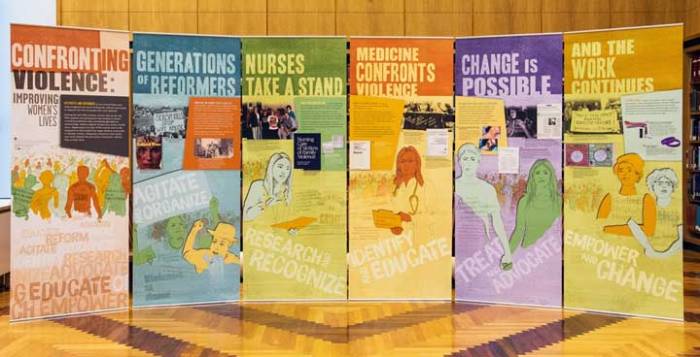On September 17, the National Library of Medicine officially opened its latest special display, Confronting Violence: Improving Women’s Lives. The project, which will be on display in the History of Medicine Division until August 19, 2016, details the history and impact of nurses addressing domestic violence. These nurses not only conducted groundbreaking research on the subject but also frequently treated women who were battered.

Confronting Violence, Improving Women’s Lives is on display in the NLM History of Medicine Division (Building 38, first floor) through August 19, 2016.
Activists and reformers in the United States have long recognized the harm of domestic violence and sought to improve the lives of women who were battered. During the late 20th century, nurses took up the call. They worked to reform a medical profession that overwhelmingly failed to acknowledge violence against women as a serious health issue. Beginning in the late 1970s, nurses were in the vanguard as they pushed the larger medical community to identify victims, adequately respond to their needs, and work towards the prevention of domestic violence.
Confronting Violence was developed by the Exhibition Program at NLM and guest curated by Catherine Jacquet, PhD, an assistant professor of history and women’s and gender studies at Louisiana State University. In addition to the physical exhibition at NLM, much of the content of Confronting Violence can also be viewed on its companion Web site and through the banner display that comprises the traveling version of the exhibition.
Why Confronting Violence?
Confronting Violence tells a story that is unfamiliar to most. No one within the scholarly community has written about this chapter in history. For many, the anti-domestic violence movement seemingly came into focus during the 1985 Surgeon General’s Workshop on Violence and Public Health or with the passage of the 1994 Violence Against Women Act. Yet for years prior, nurse reformers were working on the front lines in shelters and emergency rooms across the country. They were conducting studies, analyzing data, and developing protocols for identifying and treating patients who had experienced domestic violence. Confronting Violence tells this powerful story, drawing largely from the materials in the collections of the NLM History of Medicine Division.
How did this exhibition come about?
In 2009 the Exhibition Program was approached by Nancy McCall, the director of the Alan Mason Chesney Medical Archives at the Johns Hopkins Medical Institutions. Two faculty members in the Johns Hopkins School of Nursing, who had been among the vanguard of nurse activists who changed the way the medical profession responded to domestic violence, had some materials they believed could form the basis of an exhibition.
While the exhibition topic of nurse activists confronting domestic violence had great potential, the mission of the Exhibition Program is to highlight the collections of the National Library of Medicine, and resources were thin on this topic. Nevertheless, over the next three years, the interested parties continued discussing the idea of an exhibition and the possibility of a manuscript donation.

At the September 17, 2015 opening event, NLM Acting Director Betsy Humphreys (l.) joins (l. to r.) nurses Dr. Barbara Parker, Dr. Jacquelyn Campbell, Dr. Doris Campbell and Dr. Daniel Sheridan, along with exhibition curator Dr. Catherine Jacquet, ABC7’s Kimberly Suiters, and Patricia Tuohy, head of the Exhibition Program, NLM History of Medicine Division.
The Johns Hopkins faculty, Jacqueline Campbell, PhD, RN, and Daniel Sheridan, PhD, RN, began to assemble their papers, and they reached out to others in the movement to contribute their materials. In 2012, the History of Medicine Division, having determined that this collection represented a significant national movement within the medical profession, accepted the new manuscript collection.
With this newly acquired collection, the Exhibition Program identified a gifted historian, Catherine Jacquet, PhD, to collaborate on shaping the exhibition’s narrative. Jacquet and the Exhibition Program, using the manuscript collection as the foundation, identified a number of historical assets from other institutions, which the Exhibition Program then secured permission to reproduce or acquire via loan. After a series of refinements to hone the exhibition themes, the exhibition designer joined the team. The Exhibition Program also developed education resources and materials for educators and the general public.
After several rounds of adjustments the final design was set for both the special display and traveling version of the show. At this time the Exhibition Program began working with a Web design firm to create the companion online version. Both efforts progressed in tandem with the planning for the opening event.
Confronting Violence benefited from the work of various people in the Exhibition Program and other areas of the History of Medicine Division. Public reception to the exhibition has been positive; the traveling version of the exhibition is already booked until 2019.

The traveling version of Confronting Violence is already booked until September 2019.
By Dan Caughey, History of Medicine Division
Related Information
Companion Web site: Confronting Violence: Improving Women’s Lives
Opening Event Recording: From Private Matter to Public Health Crisis: Nursing and the Intervention into Domestic Violence
Circulating Now: Domestic Violence in the 1970s
Circulating Now: From Private Matter to Public Health Crisis



Pingback: Domestic Violence in the 1970s – Circulating Now from NLM
Pingback: Change is Possible – Circulating Now from NLM
Pingback: Nurses Organize – Circulating Now from NLM
Pingback: Nurses on the Cutting Edge – Circulating Now from NLM
Pingback: Medicine and Wife Abuse in the 1970s – Circulating Now from NLM
Pingback: From Private Matter to Public Health Crisis – Circulating Now from NLM
Pingback: An Interdisciplinary Approach to Audience Engagement: Confronting Violence Visits the Florence-Lauderdale Public Library – Circulating Now from NLM
Pingback: “Confronting Violence: Improving Women’s Lives” is month long focus at Menlo Park Library — InMenlo